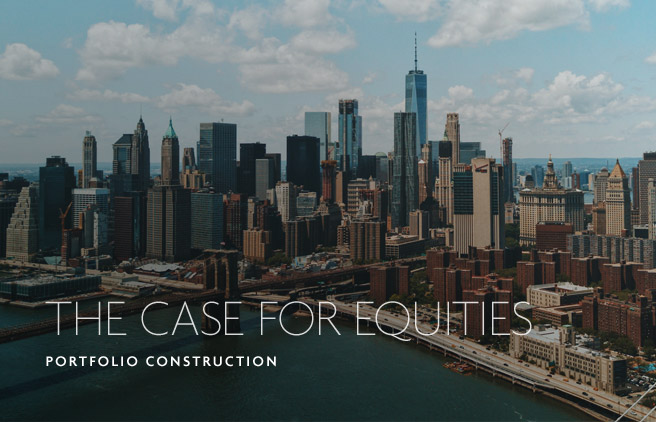
The Case for Equities
As we entered the second half of 2021, investors were focused on three main concerns:
- The COVID-19 Delta variant
- Peak growth rates, money supply and valuations
- The easing of government subsidies.
This month we’re sharing our thoughts on why—despite these concerns—it still makes sense to overweight the equity exposure in our portfolios.
The race against Delta
The Delta variant is responsible for the majority of new COVID-19 cases. While it is an obstacle in our return to normal, it’s unlikely to trigger lockdowns (which would be a set back for economies). Large percentages of the population in Canada and other developed countries are vaccinated. Those who are vaccinated and contract COVID-19 either have no or mild symptoms. In Canada, approximately 70-80% of new cases are found in unvaccinated individuals who make up 30% of the overall population. These cases will likely decline as the unvaccinated either contract COVID-19 and develop herd immunity or choose to get vaccinated. The reality is we will have to live with this virus and adjust our lifestyle (which likely includes receiving vaccines regularly).
The markets occasionally bring up the Delta variant as a cause of volatility. We disagree. Even though economies may grow below full potential for 2021 as people slowly return to their normal lifestyle (and spending habits), the pent up demand backed by savings will be unleashed in the coming quarters. This should support a more durable recovery.
The ups and downs
Economic growth
Even though growth rates have peaked, we’re still in the early stages of recovery and economies continue to grow. We anticipate both Canada and U.S. will see growth around 6% this year, followed by another above-average rate of at least 4% in 2022. Some of the recent growth constraints have been supply related and will improve overtime, such as what happened with lumber earlier this year. You may have also heard about the global chip shortage, which could continue into 2022. Chips—used in consumer electronics and even automobiles—had shortages caused by skyrocketing prices. This, in turn, has resulted in “weaker” demand as some consumers choose to wait.
Central banks and fiscal stimulus
Central banks globally grew their balance sheets by 62% (US$10) trillion since December 2019* (through the increase of money supply in the market). This will not continue forever. We anticipate central banks will start pulling back in 2021 (note the Bank of Canada has already started) and money supply will peak globally sometime in 2022. The good news is money velocity will continue to increase as it is not only saved but spent. This means the positive impacts will be lasting impacts.
Stock markets and interest rates
Stock markets are trading at higher than normal valuations. And it’s not the only outlier:
- Interest rates are close to zero
- Bond yields are below inflation across the curve
- Investors are earning nothing by leaving money in their savings accounts.
On the other hand, borrowing is extremely cheap. In the U.S. you can get a 30-year fixed-rate mortgage for less than 3%, versus above 7% in other periods. More importantly, corporate earnings are growing. Valuations are measured by two variables: prices and earnings. If prices grow but earnings don’t, that’s a problem. We anticipate earnings to grow at a faster rate than prices, bringing valuations to below 20x (above 20x is considered high for many investors).
On the job front
As job conditions improve, governments will begin cutting subsidies. It is normal to assume people need to return to work to get paid. While subsidies will be cut, their cash flows will be replaced by payrolls. We are seeing a pretty hot job market as many companies are raising wages to retain and hire.
The role of government
We’ve seen extraordinary situations in the last 12 months and expect more of the same in the next 12. Stocks will remain the preferred investments, driven by growth and continued accommodative policy. Growing our capital is not an option as inflation is expected to stay at elevated levels.
Politics rarely have long-term impacts on performance, but it is worth monitoring. In Canada, the federal election saw the Liberal’s past the post first for another minority government. The markets have largely ignored the election, both in the lead up and following, as investors see very little changes in fiscal policies with either party. We continue to have a large portion of our portfolio invested outside of Canada for diversification and to gain access to certain sectors and individual quality companies.
Obviously, government is not equal to the economy and the economy is not equal to corporate earnings. However, this may be less true for China. The central government has recently announced a new “common prosperity” theme for guiding wealth distribution in the country. It is all logical for a socialist/communist regime but is a potential nightmare for capitalists/investors. We have seen the government launching policies targeted at education, property and tech sectors, dramatically reducing their earnings power— cutting profits for investors (“the rich”) and subsidizing consumers (“the poor”). It remains a black box how far earnings will be hit, which is why we currently hold an underweight to China.
Tactical asset allocation
We take a long-term view when it comes to constructing our portfolios. But the past two years have reminded us that tactical adjustments can occur when you least expect it. As the world begins to shift back to normal (or a revised version of it), we’ll take advantage of the flexibility within our mandates to keep your investments on track and seeking new opportunities.
*Calculation includes data from the U.S. Federal Reserve, Bank of Japan, European Central Bank, Bank of England, Bank of Canada, Royal Bank of Australia and Swiss National Bank.
 By Alfred Lam, CFA, Senior Vice-President and Chief Investment Officer
By Alfred Lam, CFA, Senior Vice-President and Chief Investment Officer
Marchello Holditch, CFA, CAIA, Vice-President and Portfolio Manager, CI GAM | Multi-Asset Management
This document is intended solely for information purposes. It is not a sales prospectus, nor should it be construed as an offer or an invitation to take part in an offer. This report may contain forward-looking statements about one or more funds, future performance, strategies or prospects, and possible future fund action. These statements reflect the portfolio managers’ current beliefs and are based on information currently available to them. Forward-looking statements are not guarantees of future performance. We caution you not to place undue reliance on these statements as a number of factors could cause actual events or results to differ materially from those expressed in any forward-looking statement, including economic, political and market changes and other developments. CI Assante Wealth Management and its dealer subsidiaries, Assante Capital Management Ltd. and Assante Financial Management Ltd. (collectively “Assante”) are affiliates of CI GAM | Multi-Asset Management, which is a division of CI Global Asset Management. Evolution Private Managed Accounts are managed by CI Global Asset Management under the United Financial brand and are available exclusively through your Assante advisor. Neither CI Global Asset Management nor its affiliates or their respective officers, directors, employees or advisors are responsible in any way for damages or losses of any kind whatsoever in respect of the use of this report. Commissions, trailing commissions, management fees and expenses may all be associated with investments in mutual funds and the use of the Asset Management Service. Any performance data shown assumes reinvestment of all distributions or dividends and does not take into account sales, redemption or optional charges or income taxes payable by any securityholder that would have reduced returns. Mutual funds are not guaranteed, their values change frequently and past performance may not be repeated. Please read the fund prospectus and consult your advisor before investing. CI Assante Wealth Management is a registered business name of Assante Wealth Management (Canada) Ltd. CI Global Asset Management is a registered business name of CI Investments Inc. This report may not be reproduced, in whole or in part, in any manner whatsoever, without prior written permission of CI Assante Wealth Management. Copyright © 2021 CI Assante Wealth Management. All rights reserved.
As we entered the second half of 2021, investors were focused on three main concerns:
- The COVID-19 Delta variant
- Peak growth rates, money supply and valuations
- The easing of government subsidies.
This month we’re sharing our thoughts on why—despite these concerns—it still makes sense to overweight the equity exposure in our portfolios.
The race against Delta
The Delta variant is responsible for the majority of new COVID-19 cases. While it is an obstacle in our return to normal, it’s unlikely to trigger lockdowns (which would be a set back for economies). Large percentages of the population in Canada and other developed countries are vaccinated. Those who are vaccinated and contract COVID-19 either have no or mild symptoms. In Canada, approximately 70-80% of new cases are found in unvaccinated individuals who make up 30% of the overall population. These cases will likely decline as the unvaccinated either contract COVID-19 and develop herd immunity or choose to get vaccinated. The reality is we will have to live with this virus and adjust our lifestyle (which likely includes receiving vaccines regularly).
The markets occasionally bring up the Delta variant as a cause of volatility. We disagree. Even though economies may grow below full potential for 2021 as people slowly return to their normal lifestyle (and spending habits), the pent up demand backed by savings will be unleashed in the coming quarters. This should support a more durable recovery.
The ups and downs
Economic growth
Even though growth rates have peaked, we’re still in the early stages of recovery and economies continue to grow. We anticipate both Canada and U.S. will see growth around 6% this year, followed by another above-average rate of at least 4% in 2022. Some of the recent growth constraints have been supply related and will improve overtime, such as what happened with lumber earlier this year. You may have also heard about the global chip shortage, which could continue into 2022. Chips—used in consumer electronics and even automobiles—had shortages caused by skyrocketing prices. This, in turn, has resulted in “weaker” demand as some consumers choose to wait.
Central banks and fiscal stimulus
Central banks globally grew their balance sheets by 62% (US$10) trillion since December 2019* (through the increase of money supply in the market). This will not continue forever. We anticipate central banks will start pulling back in 2021 (note the Bank of Canada has already started) and money supply will peak globally sometime in 2022. The good news is money velocity will continue to increase as it is not only saved but spent. This means the positive impacts will be lasting impacts.
Stock markets and interest rates
Stock markets are trading at higher than normal valuations. And it’s not the only outlier:
- Interest rates are close to zero
- Bond yields are below inflation across the curve
- Investors are earning nothing by leaving money in their savings accounts.
On the other hand, borrowing is extremely cheap. In the U.S. you can get a 30-year fixed-rate mortgage for less than 3%, versus above 7% in other periods. More importantly, corporate earnings are growing. Valuations are measured by two variables: prices and earnings. If prices grow but earnings don’t, that’s a problem. We anticipate earnings to grow at a faster rate than prices, bringing valuations to below 20x (above 20x is considered high for many investors).
On the job front
As job conditions improve, governments will begin cutting subsidies. It is normal to assume people need to return to work to get paid. While subsidies will be cut, their cash flows will be replaced by payrolls. We are seeing a pretty hot job market as many companies are raising wages to retain and hire.
The role of government
We’ve seen extraordinary situations in the last 12 months and expect more of the same in the next 12. Stocks will remain the preferred investments, driven by growth and continued accommodative policy. Growing our capital is not an option as inflation is expected to stay at elevated levels.
Politics rarely have long-term impacts on performance, but it is worth monitoring. In Canada, the federal election saw the Liberal’s past the post first for another minority government. The markets have largely ignored the election, both in the lead up and following, as investors see very little changes in fiscal policies with either party. We continue to have a large portion of our portfolio invested outside of Canada for diversification and to gain access to certain sectors and individual quality companies.
Obviously, government is not equal to the economy and the economy is not equal to corporate earnings. However, this may be less true for China. The central government has recently announced a new “common prosperity” theme for guiding wealth distribution in the country. It is all logical for a socialist/communist regime but is a potential nightmare for capitalists/investors. We have seen the government launching policies targeted at education, property and tech sectors, dramatically reducing their earnings power— cutting profits for investors (“the rich”) and subsidizing consumers (“the poor”). It remains a black box how far earnings will be hit, which is why we currently hold an underweight to China.
Tactical asset allocation
We take a long-term view when it comes to constructing our portfolios. But the past two years have reminded us that tactical adjustments can occur when you least expect it. As the world begins to shift back to normal (or a revised version of it), we’ll take advantage of the flexibility within our mandates to keep your investments on track and seeking new opportunities.
*Calculation includes data from the U.S. Federal Reserve, Bank of Japan, European Central Bank, Bank of England, Bank of Canada, Royal Bank of Australia and Swiss National Bank.
 By Alfred Lam, CFA, Senior Vice-President and Chief Investment Officer
By Alfred Lam, CFA, Senior Vice-President and Chief Investment Officer
Marchello Holditch, CFA, CAIA, Vice-President and Portfolio Manager, CI GAM | Multi-Asset Management
This document is intended solely for information purposes. It is not a sales prospectus, nor should it be construed as an offer or an invitation to take part in an offer. This report may contain forward-looking statements about one or more funds, future performance, strategies or prospects, and possible future fund action. These statements reflect the portfolio managers’ current beliefs and are based on information currently available to them. Forward-looking statements are not guarantees of future performance. We caution you not to place undue reliance on these statements as a number of factors could cause actual events or results to differ materially from those expressed in any forward-looking statement, including economic, political and market changes and other developments. CI Assante Wealth Management and its dealer subsidiaries, Assante Capital Management Ltd. and Assante Financial Management Ltd. (collectively “Assante”) are affiliates of CI GAM | Multi-Asset Management, which is a division of CI Global Asset Management. Evolution Private Managed Accounts are managed by CI Global Asset Management under the United Financial brand and are available exclusively through your Assante advisor. Neither CI Global Asset Management nor its affiliates or their respective officers, directors, employees or advisors are responsible in any way for damages or losses of any kind whatsoever in respect of the use of this report. Commissions, trailing commissions, management fees and expenses may all be associated with investments in mutual funds and the use of the Asset Management Service. Any performance data shown assumes reinvestment of all distributions or dividends and does not take into account sales, redemption or optional charges or income taxes payable by any securityholder that would have reduced returns. Mutual funds are not guaranteed, their values change frequently and past performance may not be repeated. Please read the fund prospectus and consult your advisor before investing. CI Assante Wealth Management is a registered business name of Assante Wealth Management (Canada) Ltd. CI Global Asset Management is a registered business name of CI Investments Inc. This report may not be reproduced, in whole or in part, in any manner whatsoever, without prior written permission of CI Assante Wealth Management. Copyright © 2021 CI Assante Wealth Management. All rights reserved.





